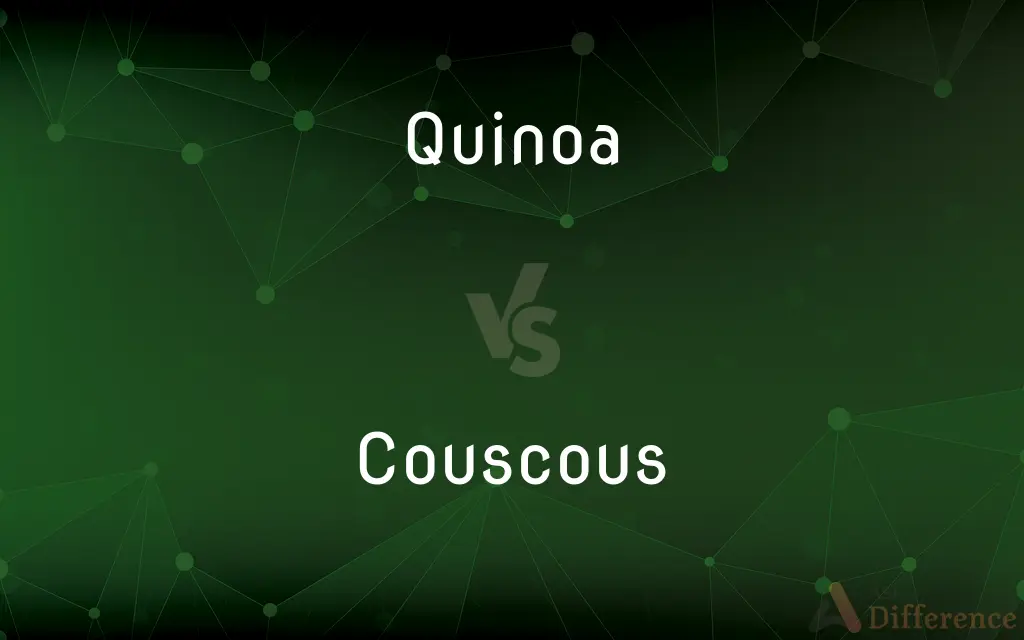Quinoa vs. Couscous — What's the Difference?
By Maham Liaqat & Urooj Arif — Updated on March 8, 2024
Quinoa is a gluten-free, protein-rich seed, while couscous is a type of pasta made from semolina wheat.

Difference Between Quinoa and Couscous
Table of Contents
ADVERTISEMENT
Key Differences
Quinoa, often referred to as a superfood, is actually a seed from the Chenopodium quinoa plant and is celebrated for its high protein content and complete set of essential amino acids. Couscous, on the other hand, originates from North African cuisine and is made by rolling and shaping semolina wheat into small granules, serving as a staple similar to rice or pasta in many dishes.
Quinoa is naturally gluten-free, making it a popular choice for those with gluten sensitivities or celiac disease. Couscous, being a wheat product, contains gluten, which can be problematic for individuals with gluten-related disorders.
Nutritionally, quinoa boasts a higher fiber content and is considered a complete protein, containing all nine essential amino acids, which is rare in plant-based foods. Couscous provides a good source of carbohydrates and is relatively low in fat, but it doesn't match quinoa's protein quality or fiber content.
Cooking methods for both are somewhat similar, typically involving boiling in water or broth until tender, but quinoa also requires rinsing before cooking to remove its natural coating of saponins, which can impart a bitter taste.
While both quinoa and couscous are versatile and can be used in a variety of dishes, from salads to main courses, their nutritional profiles and suitability for those with dietary restrictions differ significantly.
ADVERTISEMENT
Comparison Chart
Type
Seed
Pasta (wheat product)
Gluten Content
Gluten-free
Contains gluten
Protein
High, complete protein (all essential amino acids)
Moderate, not a complete protein
Fiber
Higher fiber content
Lower fiber content
Cooking
Requires rinsing, boiled until water is absorbed
Boiled or steamed until tender
Compare with Definitions
Quinoa
Classified as a pseudocereal, not a grain.
Quinoa is often used as a grain substitute in salads and bowls.
Couscous
Made from semolina wheat granules.
Couscous is a common staple in North African and Middle Eastern cuisines.
Quinoa
High in fiber, vitamins, and minerals.
Quinoa is often highlighted for its iron, magnesium, and B-vitamin content.
Couscous
Not suitable for gluten-free diets.
Those with gluten sensitivities should avoid couscous in favor of gluten-free grains.
Quinoa
Safe for those with celiac disease or gluten intolerance.
Quinoa serves as a gluten-free alternative to wheat-based sides.
Couscous
Known for its fast preparation time.
Instant couscous can be prepared in just a few minutes by adding boiling water.
Quinoa
Contains all nine essential amino acids.
Quinoa is a favored protein source in vegetarian and vegan diets.
Couscous
Comes in several sizes, from fine to pearl (Israeli couscous).
Pearl couscous has a larger, chewier texture compared to traditional fine couscous.
Quinoa
Must be rinsed to remove saponins before cooking.
Properly rinsed quinoa ensures a bitter-free, fluffy texture upon cooking.
Couscous
Primarily serves as a carb side dish.
Couscous is often used as a base for stews and vegetable medleys.
Quinoa
Quinoa (Chenopodium quinoa; , from Quechua kinwa or kinuwa) is a flowering plant in the amaranth family. It is a herbaceous annual plant grown as a crop primarily for its edible seeds; the seeds are rich in protein, dietary fiber, B vitamins, and dietary minerals in amounts greater than in many grains.
Couscous
Couscous is a North African dish of small (about 3 millimetres (0.12 in) in diameter) steamed balls of crushed durum wheat semolina that is traditionally served with a stew spooned on top. Pearl millet and sorghum, especially in the Sahel, and other cereals can be cooked in a similar way and the resulting dishes are also sometimes called couscous.
Quinoa
A goosefoot (Chenopodium quinoa) native to the Andes and cultivated for its edible seeds.
Couscous
A pasta of North African origin made of semolina or other grains, formed into small pellets and usually steamed.
Quinoa
The seeds of this plant, used as food.
Couscous
A North African dish consisting of this pasta served with stewed vegetables or meat.
Quinoa
A goosefoot (Chenopodium quinoa) native to the Andes and cultivated for its edible seeds.
Couscous
A pasta of North African origin made of crushed and steamed semolina.
Quinoa
The high-protein dried fruits and seeds of this plant, used as a food staple and ground into flour.
Couscous
A kind of food used by the natives of Western Africa, made of millet flour with flesh, and leaves of the baobab; - called also lalo.
Quinoa
The seeds of a kind of goosewort (Chenopodium Quinoa), used in Chili and Peru for making porridge or cakes; also, food thus made.
Couscous
A spicy dish that originated in northern Africa; consists of pasta steamed with a meat and vegetable stew
Couscous
A pasta made in northern Africa of crushed and steamed semolina
Common Curiosities
Can quinoa be used as a direct substitute for couscous in recipes?
Yes, but note the differences in taste, texture, and nutritional value.
Are quinoa and couscous interchangeable for gluten-free diets?
Only quinoa is suitable for gluten-free diets, as couscous contains gluten.
Is couscous a healthy grain?
Couscous can be part of a healthy diet, providing carbohydrates and fiber, but lacks the complete protein profile of quinoa.
What are some popular dishes that use quinoa or couscous?
Quinoa is often used in salads, bowls, and as a rice substitute, while couscous is common in Mediterranean and Middle Eastern dishes like tagines.
How long does it take to cook quinoa compared to couscous?
Quinoa typically cooks in about 15-20 minutes, while couscous can be prepared in just 5-10 minutes.
Why do you need to rinse quinoa before cooking?
Rinsing removes quinoa's natural coating of saponins, which can taste bitter.
Is quinoa or couscous better for weight loss?
Both can be part of a weight loss diet, but quinoa's higher fiber and protein may help with satiety and appetite control.
What is the main difference between quinoa and couscous?
Quinoa is a gluten-free seed with high protein, while couscous is a wheat-based pasta.
How does the protein content in quinoa benefit vegetarians and vegans?
As a complete protein, quinoa provides all essential amino acids, making it an excellent protein source for plant-based diets.
Can couscous be made gluten-free?
Traditional couscous is not gluten-free, but gluten-free alternatives made from corn or rice flour are available.
Share Your Discovery

Previous Comparison
Carefree vs. Careless
Next Comparison
Nickel vs. SilverAuthor Spotlight
Written by
Maham LiaqatCo-written by
Urooj ArifUrooj is a skilled content writer at Ask Difference, known for her exceptional ability to simplify complex topics into engaging and informative content. With a passion for research and a flair for clear, concise writing, she consistently delivers articles that resonate with our diverse audience.
















































